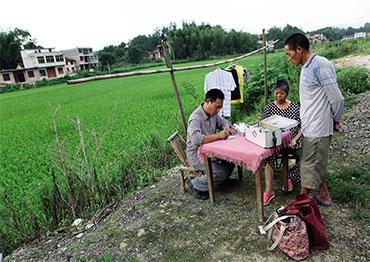In 1967, Ma Wenfang, who had graduated from junior high school, was selected as a barefoot doctor and sent to train for one year. He learned modern anatomy, physiology and diagnosis, traditional Chinese medicine (TCM) and acupuncture.
During the commune period, rural residents did not receive a salary, instead earning work points, a measurement to evaluate an individual’s work contributions. The points were linked to the food individuals could get, which was distributed by the production brigade.
Ma said barefoot doctors could earn up to 280 work points a month, much higher than ordinary villagers. Commune members had to pay a small sum toward the medical system, Ma said, which in his village was 0.1 yuan (1.5 cents) every month. The rest was covered by the village collective economy. ��
“Because barefoot doctors have limited professional medical capacity, they could really just treat basic health problems. It can only be said that under the conditions, barefoot doctors provided help to common folk at that time,” Zhang Daqing, head of the Department of Medical History and Philosophy of Medicine at Peking University Health Science Center, told NewsChina.
According to the book Creation and Reconstruction – Research on the Rural Cooperative Medical System and Barefoot Doctor Phenomenon during Collectivization Period by Li Decheng, associate professor with Jiangxi Normal University, by the mid-1960s, due to continuous learning, practice and training, barefoot doctors had the skill to treat dozens of common diseases, knew how to use dozens of drugs, as well as other knowledge including acupuncture and TCM.
At that time, medicines were in short supply and prices were high. Ma said that if people caught a serious cold, they would spend 0.02 yuan for two aspirin pills, and if that was not enough, they would have a penicillin shot, which had a nationally set price of 0.18 yuan.
“It was a planned economy and there was a quota system for the distribution of precious antibiotics like penicillin,” Ma said. “Each village could get at most 10 shots of penicillin a month.”
Zhang Daqing believes that barefoot doctors played a positive role in the modernization of drug popularization in rural areas. Ma said barefoot doctors helped solve the dilemma of lack of medicine and doctors in rural areas. But barefoot doctors, unlike the previous traditional and folk medical practices of local healers, were positioned and arranged in an institutionalized political atmosphere.
Barefoot doctors also shouldered the responsibility for general hygiene, including ensuring villagers had clean drinking water, a clean rural environment, proper disposal of human feces and pest control. During the 1960s when malaria was endemic, villagers did not know how to prevent it. Ma went to each household to deliver medicine and educate locals on malaria prevention. Ma cajoled every villager to take the medicine and monitored them after. Eradicating malaria in the village took two years.
“A barefoot doctor diagnoses and treats simple illnesses, but his main duties are in health education and preventive medicine,” says an article published in the British Medical Journal in 1974 titled “Barefoot Doctors and the Medical Pyramid.” The article continued that it was the barefoot doctor’s job to teach commune members about simple personal hygiene and to make sure that “children and adults are immunized against infectious diseases, and to lead campaigns about birth control and the eradication of pests such as flies and mosquitoes.”
Li Decheng thought barefoot doctors and the rural cooperative medical system were products of scarce medical resources and their severe uneven distribution. In his doctoral dissertation titled “Cooperative Medical System and Barefoot Doctors (1955-1983),” he wrote that it was the barefoot doctors who successfully implemented instructions from higher medical administrations, such as ensuring smallpox vaccinations were done and distributing epidemic control drugs in an extraordinarily fast and efficient way.

 Old Version
Old Version




